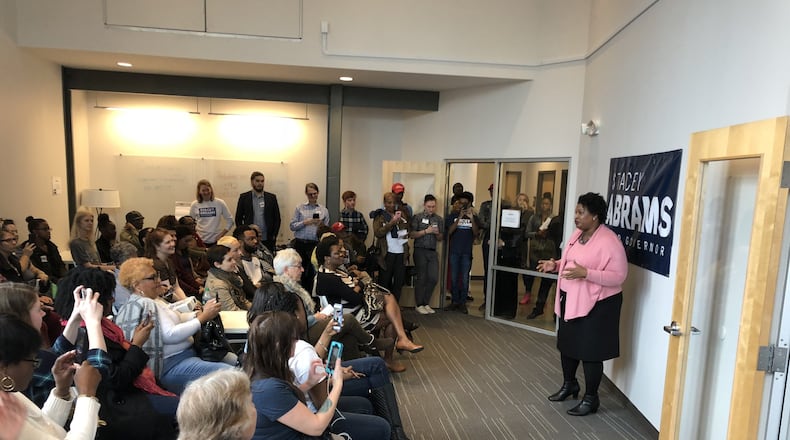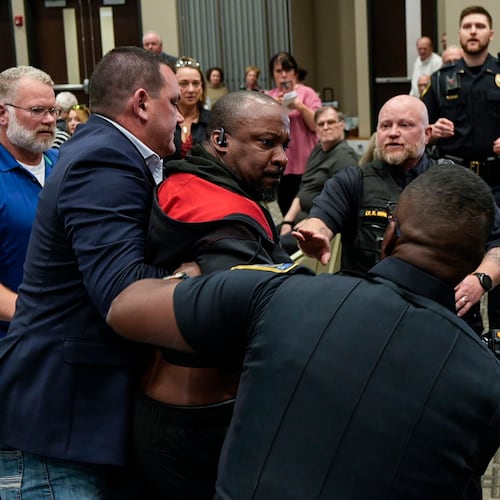At house after house, the volunteers for Democrat Stacey Abrams’ campaign were met with confusion, excitement, indifference or a combination of the three. Many didn’t know there was a governor’s race at the end of the year — or a primary competition looming in May.
And knocking on many of those doors was Patricia Fulton, who gamely handled each annoyed look and intense question about the candidate and her policies.
“I have no idea who she is — is she in a certain district?” said one east Atlanta voter, who only gave his name as Stanley. “Is she Democrat or Republican?”
Fulton handed him a pamphlet with Abrams’ smiling face and informed him she was a Democrat running statewide for governor.
“OK,” he offered. “Then I’ll probably vote for her.”
For Fulton and the thousands of other volunteers hitting doors, this phase of the election is about planting seeds with voters. The primary is less than four months away and many have yet to tune in, but the campaigns hope the painstaking grass-roots work flowers into votes.
Each of the seven leading candidates to succeed Gov. Nathan Deal is fast organizing field operations to try to transform supporters into voters. But none has spent as much campaign cash as early as Abrams, who has focused on building a get-out-the-vote operation.
She’s burned through roughly 80 percent of the $2.3 million she’s raised, spending a chunk of it hiring staff, corralling volunteers and plans to open nearly a dozen field offices. She’s also doled out $25,000 for travel expenses and $84,000 for security.
Her campaign manager, Lauren Groh-Wargo, revealed the approach to spending money aggressively early in a confidential memo obtained by The Atlanta Journal-Constitution. She said raising cash to spend mostly on broadcast advertisements is a "losing formula" in Georgia.
“Too many campaigns in Georgia have neglected laying the necessary groundwork for a robust grassroots effort in the early months of campaigns,” the memo states, “and when investments in a ground game have been made in the late summer of the election year it has been too little, too late.”
It is a gutsy strategy that defies conventional campaign wisdom. Abrams’ top rivals have steadily built their campaign accounts so they can splurge closer to the May 22 vote, rather than spend big sums now. The leading Republicans all boast seven-figure campaign coffers. So does former state Rep. Stacey Evans, the other prominent Democrat in the race.
“The idea that you raise a lot of money and spend as little as possible until close to the vote is the typical approach,” said Michael Owens, the Cobb County Democratic chairman and operative who has not picked a side in the race. “But the races we’ve been able to win are because we have effective field campaigns. This is an unusual strategy, but it could pay off.”
There’s no guarantee it will work, and there’s a risk that relying too heavily on this type of get-out-the-vote operation could backfire.
In last year's 6th Congressional District special election, Jon Ossoff flooded Atlanta's northern suburbs with TV ads and volunteers who knocked on some doors so often that even supporters turned them away. Some conservatives said it helped jolt them to defend their territory.
Carmen Foskey, the executive director of the Georgia GOP, took to Twitter to call Abrams’ rate of spending “radical” before lumping her in with her opponent.
“I don’t even want to think about what kind of burn rate the Stacey’s would have with my tax dollars,” she wrote.
‘Georgians First’
Evans amassed roughly the same amount of campaign cash as Abrams — thanks in part to a $1.25 million infusion from her personal account — but she’s taking a different approach to spending it.
She’s saved $1.5 million of the $2.3 million she’s collected since last year, planning to spend it more aggressively closer to the primary. Nearly all of that sum will be available for the May vote, while only about $180,000 of the $460,000 Abrams has left in her account is specifically earmarked for the primary.
“It’s important for whoever is the Democratic nominee to be able to go toe to toe with the Republican candidate,” Evans said. “Financial management, and the ability to raise in-state money, is relevant. And I believe that we’ve shown I’m the candidate who can do that.”
Several Republican candidates presumably start with higher name recognition — Lt. Gov. Casey Cagle and Georgia Secretary of State Brian Kemp have both won multiple statewide contests — but they’re also casting early attention to ground-game efforts.
Cagle’s campaign organized a bus tour last year that stretched through 18 stops across North Georgia. He’s focused on signing up county sheriffs — he had 103 endorsements at last count — and plans to launch a volunteer canvassing operation within the month.
He also touts a network of about 18 “volunteer-run field outposts” — largely in rural areas — where his volunteers store signs and host phone-banking operations.
His GOP rivals are beefing up, too. Both Kemp and former state Sen. Hunter Hill raced to become the first to announce they had organized campaign operations in all 159 of Georgia’s counties. Each boasts a lengthy list of local officials and civic leaders who have signed on to help.
Kemp plans to ratchet up his grass-roots game this month with a “Putting Georgians First Bus Tour” that will trek to 50 counties over 10 days. And Hill’s campaign said his volunteers travel to 80 events each month to spread his message. His strategists are particularly proud of his straw poll victories, which include a vote he won last year at the state GOP meeting.
State Sen. Michael Williams jets from the legislative session to campaign events across the state, and he has gathered about 2,700 volunteers. Newcomer Clay Tippins, a business executive running for public office for the first time, has tried to build his network from scratch since jumping in the race in November.
‘Up in the air’
On a dreary recent Saturday morning, more than 100 volunteers at Abrams’ campaign headquarters warmed up with some light calisthenics before a day of dialing phones and knocking on doors.
Chris Smith, who coordinates the campaign’s volunteers, ticked through policy points he wanted door-knockers to highlight, such as Abrams’ cradle-to-career education plan. He encouraged them to look voters in the eyes and try to connect personally with each one.
They used sophisticated iPhone apps, complete with sample scripts and pinpoint GPS mapping, as they hit the streets. After each discussion, the canvassers rated voters’ attitudes on a 1-5 scale — the lower the rating, the bigger an Abrams fan.
The campaign said it has reached out to 600,000 voters through door-to-door canvassing, phone banks and other outreach programs. And on this drizzly weekend, Fulton visited about two dozen homes, dispensing a mix of mostly threes and fours to voters over the course of a few hours.
“I went to law school with Stacey Evans, and I’m still thinking about her,” said Rachel, a homeowner who was conflicted about the contest. “I like both of them, but I’m up in the air.”
Near the end of her route, Fulton arrived at the stoop of Timothy Bell, a Democratic voter who eagerly peppered her with questions.
“How does she feel about the state takeover — you know, when the state tried to take over public schools?” he asked, the opening salvo of 10 minutes of queries about Abrams’ k-12 proposals and criminal justice policies.
When Bell was finished, Fulton trotted down from his front porch with an ear-to-ear smile. Bell signed up to volunteer for the campaign, she said, fingers flying on her phone.
That surely counted as a one.
About the Author
Keep Reading
The Latest
Featured




